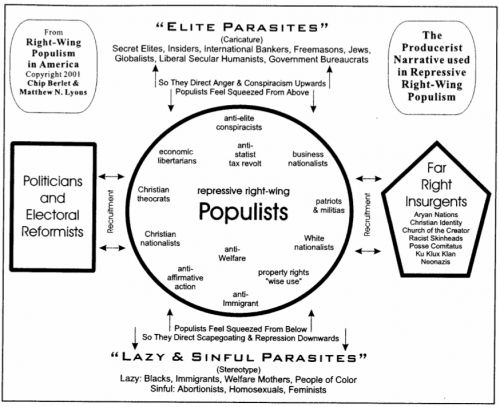Excerpt: Sectors of the US Right—Active in the Year 2001
With the political talk about Rush Limbaugh being in charge of the Republican party I—serendipously while cleaning out my office—came across a list of definitions for the US Right from Defending Democracry: An activist resource kit. In reading over the list, the question for me that comes to mind is: if that’s the Right, what is the Left?
There is much overlap and sectors are not mutually exclusive. Populist, apocalyptic, and conspiracist styles can be found in several sectors. Methodologies range from cautious moderation, to activism, to insurgency, to violence. Forms of oppression—racism, sexism, homophobia, antisemitism—vary in each sector.
THE CONSERVATIVE RIGHT
Secular Right
Corporate Internationalists—Nations should control the flow of people across borders, but not the flow of goods, capital, and profit. Sometimes called the “Rockefeller Republicans.” Globalists.
Business Nationalists—Multinational corporations erode national sovereignty; nations should enforce borders for people, but also for goods, capital, and profit through trade restrictions. Enlists grassroots allies among Regressive Populists. Anti-Globalists.
Economic Libertarians—The state disrupts the perfect harmony of the free market system. Modern democracy is essentially congruent with capitalism.
National Security Militarists—Support U.S. military supremacy and unilateral use of force to protect U.S. national security interests around the world. A major component of Cold War anticommunism.
Neoconservatives-–The egalitarian social liberation movements of the 1960s and 1970s undermined the national consensus. Intellectual oligarchies and political institutions preserve democracy from mob rule.
Christian Right
Christian Nationalists—Biblically-defined immorality and sin breed chaos and anarchy. America’s greatness as Godʼs chosen land has been undermined by liberal secular humanists, feminists, and homosexuals. Purists want litmus tests for issues of abortion, tolerance of gays and lesbians, and prayer in school. Includes some non-Christian cultural conservatives. Overlaps somewhat with Christian theocracy.
THE HARD RIGHT
Christian Theocrats—Christian men are ordained by God to run society. Eurocentric version of Christianity based on early Calvinism. Intrinsically Christian ethnocentric, treating non-Christians as second-class citizens. Implicitly antisemitic. Includes soft dominionists and hardline Reconstructionists.
XENOPHOBIC RIGHT
Paleoconservatives—Ultraconservatives and reactionaries. Natural financial oligarchies preserve the republic against democratic mob rule. Usually nativist (White Racial Nationalist), sometimes antisemitic or Christian nationalist. Elitist emphasis is similar to the intellectual conservative revolutionary wing of the European New Right. Often libertarian.
Regressive Popular Patriots—Secret elites control the government and banks. The government plans repression to enforce elite rule or global collectivism. The patriot and armed militia movements are one response from this sector. Americanist. Often supports Business Nationalism due to its isolationist emphasis. Anti-Globalists, yet support noninterventionist national security militarism. Repressive towards scape-goated targets below them on socio-economic ladder.
White Nationalists—Alien cultures make democracy impossible. Cultural Supremacists argue different races can adopt the dominant (White) culture; Biological Racists argue the immutable integrity of culture, race, and nation. Segregationists want distinct enclaves, Separatists want distinct nations. Americanist. Tribalist emphasis is similar to the race-is-nation wing of the European New Right.
Far Right or Ultra Right—Militant forms of insurgent or revolutionary right ideology. Separatist or genocidalist ethnocentric nationalism. Reject pluralist democracy for an organic oligarchy that unites the idealized homogeneic nation. Conspiracist views of power that are overwhelmingly antisemitic. Home to overt fascists, neo-nazis, Christian Identity, Church of the Creator.
There was also in the book an interesting graphic explaining the “Producerist Narrative used in Repressive Right Wing Populism” from Right Wing Populism in American: Too Close for Comfort. I think it’s an interesting use of design to explain a dynamic narrative (click the image to view a larger version):
And as a chaser, it would be could to review The 7 Things Everyone Wants—specifically #4.
